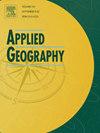从全球和地方视角解读土地利用和人口结构影响下城市碳强度的动态和差异
IF 5.4
2区 地球科学
Q1 GEOGRAPHY
引用次数: 0
摘要
及时准确地评估土地利用和人口结构对碳强度(CI)变化的影响,对有效的减排政策至关重要。然而,驱动这些影响的相互依赖关系尚未完全了解。本研究考察了中国城市CI的空间异质性和动态,重点研究了土地利用模式和人口因素在城市CI中的作用。结果表明,尽管城市CI总体下降,但碳不平等加剧。值得注意的是,以前缩小的区域差距现在已经分化,主要是由于区域集群内部的差异越来越大。城市CI存在显著的空间分异,北部地区CI高于南部地区CI。城市CI的空间整合受到路径依赖和锁定效应的强烈影响,即使在持续的区域间竞争中也是如此。城市CI的内生效应表明,邻近地区增加1%对应的本地CI至少增加0.5%。全球回归表明,城市化、劳动参与和收入对城市CI有正向影响,老龄化、技术进步、产业升级和研发投入对城市CI有负向影响,且存在直接效应和溢出效应。局部回归分析揭示了明显的空间异质性,土地城市化(占71.8%)和人口老龄化(60.9%)成为这些关系中最重要的两个决定因素。这些发现揭示了将土地利用和人口概况纳入碳减排战略的必要性,倡导因地而定的干预措施,以有效缓解城市CI。本文章由计算机程序翻译,如有差异,请以英文原文为准。

Decoding the dynamics and disparities of urban carbon intensity under the influence of land use and demographics from both global and local perspectives
Timely and accurate assessment of how land use and demographics affect carbon intensity (CI) variations matters to effective reduction policies. However, the interdependencies driving these effects are not yet fully understood. This study examines the spatial heterogeneity and dynamics of urban CI in China, focusing on the roles of land use patterns and demographic factors. Results show that despite an overall decline in urban CI, carbon inequality has worsened. Notably, previously narrowing regional disparities have now diverged, driven mainly by growing variations within regional clusters. There are significant spatial differentiation in urban CI, with northern regions exhibiting higher values compared to southern regions. The spatial integration of urban CI is strongly shaped by path dependency and lock-in effects, even amid persistent inter-regional competition. The endogenous effect of urban CI suggests that a 1 % increase in neighboring areas corresponds to at least a 0.5 % increase locally. The global regression demonstrates that urbanization, labor participation, and income positively affect urban CI, while aging, technological progress, industrial upgrading, and R&D investment negatively influence it, with both direct and spillover effects observed. Local regression analysis uncovers pronounced spatial heterogeneity, with land urbanization (accounting for 71.8 %) and population aging (60.9 %) emerging as the two most significant determinants in these relationships. These findings shed light on the need to integrate land use and demographic profiles into carbon abatement strategies, advocating for locally tailored interventions to effectively mitigate urban CI.
求助全文
通过发布文献求助,成功后即可免费获取论文全文。
去求助
来源期刊

Applied Geography
GEOGRAPHY-
CiteScore
8.00
自引率
2.00%
发文量
134
期刊介绍:
Applied Geography is a journal devoted to the publication of research which utilizes geographic approaches (human, physical, nature-society and GIScience) to resolve human problems that have a spatial dimension. These problems may be related to the assessment, management and allocation of the world physical and/or human resources. The underlying rationale of the journal is that only through a clear understanding of the relevant societal, physical, and coupled natural-humans systems can we resolve such problems. Papers are invited on any theme involving the application of geographical theory and methodology in the resolution of human problems.
 求助内容:
求助内容: 应助结果提醒方式:
应助结果提醒方式:


